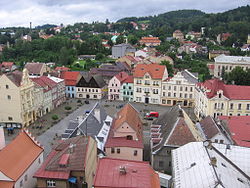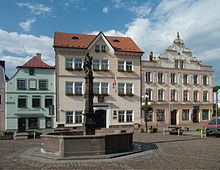world.wikisort.org - Czech
Česká Kamenice (Czech pronunciation: [ˈtʃɛskaː ˈkamɛɲɪtsɛ]; German: Böhmisch Kamnitz) is a town in Ústí nad Labem Region of the Czech Republic. It has about 5,000 inhabitants. The town centre is well preserved and is protected by law as an urban monument zone.
Česká Kamenice | |
|---|---|
Town | |
 Míru Square, historic centre | |
 Česká Kamenice Location in the Czech Republic | |
| Coordinates: 50°47′52″N 14°25′4″E | |
| Country | |
| Region | Ústí nad Labem |
| District | Děčín |
| First mentioned | 1352 |
| Government | |
| • Mayor | Jan Papajanovský |
| Area | |
| • Total | 38.77 km2 (14.97 sq mi) |
| Elevation | 301 m (988 ft) |
| Population (2022-01-01)[1] | |
| • Total | 5,028 |
| • Density | 130/km2 (340/sq mi) |
| Time zone | UTC+1 (CET) |
| • Summer (DST) | UTC+2 (CEST) |
| Postal code | 407 21 |
| Website | www |
Administrative parts
Villages of Dolní Kamenice, Filipov, Horní Kamenice, Huníkov, Kamenická Nová Víska, Kerhartice, Líska, Pekelský Důl and Víska pod Lesy are administrative parts of Česká Kamenice.
Geography
Česká Kamenice is located about 13 kilometres (8 mi) east of Děčín. The municipal territory is hilly and extends into three geomorphological regions: Lusatian Mountains, Central Bohemian Uplands and Elbe Sandstone Mountains. The highest peak is Studenec with 737 metres (2,418 ft) above sea level.
The river Kamenice and several brooks flow through Česká Kamenice.
History
The first written mention of Česká Kamenice is from 1352. The town was founded at the crossroads of two paths, the so-called "Bohemian Road" and the "Lusatian Road", probably in the area of an older Slavic settlement. It was founded before 1283, probably in the 1270s during the reign of King Ottokar II, when the colonization of the region culminates mainly in settlers from neighbouring Saxony.[2]
Concentration camp
In spring 1944, the Rabstein sub-camp of Flossenbürg concentration camp was created here, with a capacity of 600 prisoners. At the end of the war, 1,500 inmates were incarcerated in the camp. The camp provided workers for the nearby underground aircraft factory in the town of Janská, 3 km west of Česká Kamenice. The number of inmate deaths is not known due to the destruction of all camp documentation. The foundations of the camp buildings remain visible, along with a memorial and historical overview.[3]
Demographics
|
|
| ||||||||||||||||||||||||||||||||||||||||||||||||||||||
| Source: Censuses[4][5] | ||||||||||||||||||||||||||||||||||||||||||||||||||||||||
Sights

Míru Square and its surroundings form the historic town centre. The stone renaissance fountain on the square is from 1574. The main landmarks of the centre are Church of Saint James the Great, Evangelical church, Pilgrimage Chapel of the Nativity of the Virgin Mary, Kamenice Chateau and Salhausen Chateau. There are many preserved houses in Neoclassical and Art Nouveau styles.[6]
Due to the natural conditions, there are several rocky lookouts in the area. On Studenec, there is an iron observation tower from 1888, a technical monument. A ruin of Česká Kamenice Castle is preserved on the Zámecký hill, in its premises there is a wooden observation tower.[7]
The remains of the concentration camp and the underground aircraft factory contains an exposition and under certain conditions are open to the public.[7]
Notable people
- Joseph Rothe (1759–1808), operatic singer
- Johann Baptist Emanuel Pohl (1782–1834), botanist, entomologist, geologist and physician
- Hannes Hegen (1925–2014), illustrator and caricaturist
Antonín Dvořák took further organ and music-theory lessons at Česká Kamenice with Franz Hanke.
Twin towns – sister cities
Česká Kamenice is twinned with:[8]
 Bad Schandau, Germany
Bad Schandau, Germany
Gallery
- Church of Saint James the Great
- Chapel of the Nativity of the Virgin Mary
- Salhausen Chateau
- Kamenice Castle
- Rabštejn underground factory
- Observation tower on Studenec
References
- "Population of Municipalities – 1 January 2022". Czech Statistical Office. 2022-04-29.
- "Historie města" (in Czech). Město Česká Kamenice. Retrieved 2021-07-15.
- "Museum of concentration camp of underground airfactory in Rabstejn". Archived from the original on 2005-07-28.
- "Historický lexikon obcí České republiky 1869–2011 – Okres Děčín" (in Czech). Czech Statistical Office. 2015-12-21. pp. 1–1.
- "Population Census 2021: Population by sex". Public Database. Czech Statistical Office. 2021-03-27.
- "Městská památková zóna Česká Kamenice" (in Czech). Město Česká Kamenice. Retrieved 2021-07-15.
- "Kulturní památky, Turistické cíle" (in Czech). Město Česká Kamenice. Retrieved 2021-07-15.
- "Partnerské město Bad Schandau" (in Czech). Město Česká Kamenice. Retrieved 2020-08-19.
External links
| Wikimedia Commons has media related to Česká Kamenice. |
- Official website (in Czech)
- Microregion Českokamenicko (in Czech)
- Historical postcards of Česká Kamenice
- Virtual show
Другой контент может иметь иную лицензию. Перед использованием материалов сайта WikiSort.org внимательно изучите правила лицензирования конкретных элементов наполнения сайта.
WikiSort.org - проект по пересортировке и дополнению контента Википедии








